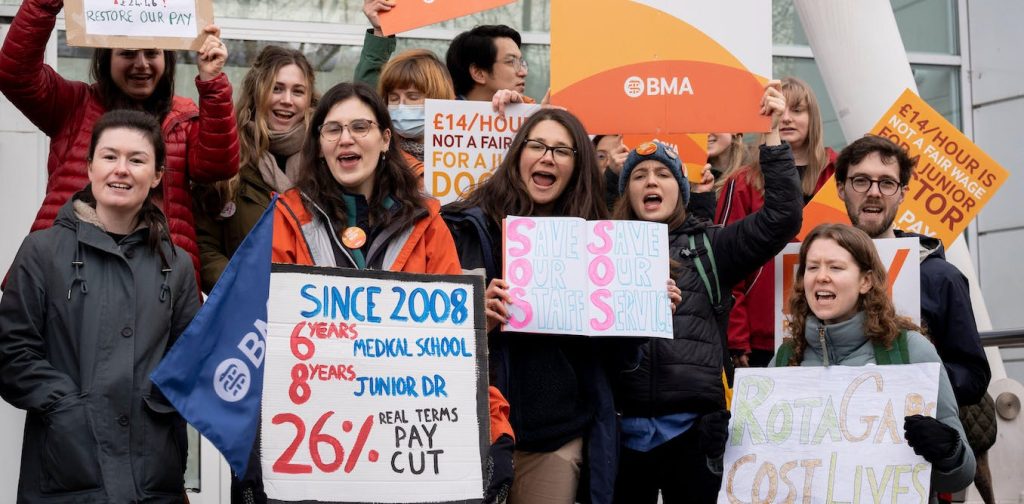More than 36,000 junior doctors across England, Scotland and Wales are on strike from April 11-15. This is the second junior doctor strike this year. The key reason for these strikes is pay, with calls to increase junior doctor salaries by 35%.
But this isn’t the only reason many junior doctors are striking. The strain of working through COVID-19, increasing demands on health services, and growing numbers of medical and nursing colleagues leaving the NHS are all causing stress and burnout for junior doctors. Many hope these strikes may bring about much-needed improvements to their working conditions and ability to provide quality care to their patients.
Mounting pressure
There are almost 70,000 junior doctors working in the UK, most of them within the NHS.
While many people may assume a junior doctor is an intern or someone still at medical school, this is actually the label given to any doctor in the UK who has completed their basic medical school education and is continuing medical training.
After medical school, doctors undertake two years of foundation training, then continue training in their chosen speciality under the supervision of a consultant doctor for 3-8 years. This means that, in addition to their 4-7 years of medical school, some junior doctors may be practising for ten years or more.
But not only do junior doctors learn from their supervising consultants, they also conduct much of the day-to-day clinical work of in NHS hospitals and other services. They perform the bulk of diagnoses, clinical procedures, and ongoing management of patients.
They also oversee the medical students and foundation doctors in their teams, and are responsible for running clinical services and departments outside core hours, working overnight and on weekends – with their supervising consultants “on call” for emergencies only.
The pressures on NHS services continue to worsen. Demand for healthcare is rising as the population grows and ages – but staff and bed numbers aren’t keeping pace. Staff shortages in general practice mean an overflow of patients to hospital emergency departments and long waits for admission, as well as lengthy waiting lists for non-emergency treatment.
These pressures make for a heavy, exhausting and constant workload for staff – particularly junior doctors who must juggle patient care with training.
Lucy North / Alamy Stock Photo
When workload pressures and poor working conditions affect a doctor’s ability to provide good care, they can suffer from burnout. Burnout happens more often in healthcare professionals compared with the general working population because of the emotionally-taxing, high-energy nature of the job. According to figures from 2022, more than 60% of junior doctors in the UK were at risk of suffering burnout.
Burnout is dangerous for both physical and mental wellbeing. Sickness absence rates in the NHS are higher than in any other sector of the economy. The most recent NHS staff survey found almost 46% of NHS staff reported feeling unwell in the last 12 months as a result of workplace stress.
Burnout also increases risks of self-harm and suicide. There have been several recent high-profile cases of NHS junior doctor deaths by suicide directly linked to working conditions. Globally, doctors have the highest rate of suicide compared with any other profession.
Leaving the NHS
The immense pressure and burnout that junior doctors experience in the NHS has seen a growing number choosing to leave their roles – either to move overseas to practice medicine, or leaving the profession altogether.
In 2011, 71% of junior doctors stayed in training from foundation year to specialisation. Eight years later, this figure was down to only 37%. Poor salary, reduced training opportunities, unmanageable work schedules and the impact of being short-staffed are all behind this trend.
Around 4,800 doctors leave the UK each year to practice medicine overseas – 70% of whom are under 40. Many move to Australia and New Zealand, which last year launched large-scale recruitment campaigns for healthcare workers in the UK and Ireland, promoting better salaries, working conditions, and quality of life for doctors.
By 2031, it’s estimated that half a million extra healthcare staff will be needed by the NHS to meet the rising demand for healthcare. But with staff including junior doctors leaving at such alarming rates due to poor working conditions, burnout and low pay, the NHS will struggle to attract enough recruits from UK and other medical schools to break the workforce crisis cycle. This in turn will continue to restrict the NHS’s ability to provide safe and efficient healthcare.
Will striking help?
In 2010, NHS staff budgets were tightened under the UK government’s austerity measures, meaning that pay increments for all staff were capped between 1-2% from 2010-2022. But inflation rates since then have been consistently higher than these pay rises.
So, junior doctors’ salaries haven’t increased as fast as the cost of living. In fact, they’ve experienced a 26% real-terms pay cut since 2008. Yet in the same period, the pressures on junior doctors – including from COVID-19, higher numbers of sicker patients, and increased workloads – have only been mounting, influencing their decisions as to whether to stay in the NHS.
Increasing pay may be one solution to improve junior doctor retention. This is likely to increase work satisfaction and morale, which would improve wellbeing and protect against burnout. Higher retention and lower burnout is, in turn, likely to significantly improve working conditions across the NHS – not just for junior doctors but all NHS staff.
But at the same time, attention also needs to be placed on making improvements at an organisational level for junior doctors. Basic things such as rest areas and shower facilities, access to food and drink on shift, safe security and car parking, regular breaks and adequate equipment are all often missing for junior doctors (and all staff) at work.
Alongside pay, these fundamentals should be prioritised – along with introducing much needed system-wide approaches to improve the psychological wellbeing of junior doctors and all NHS staff.

